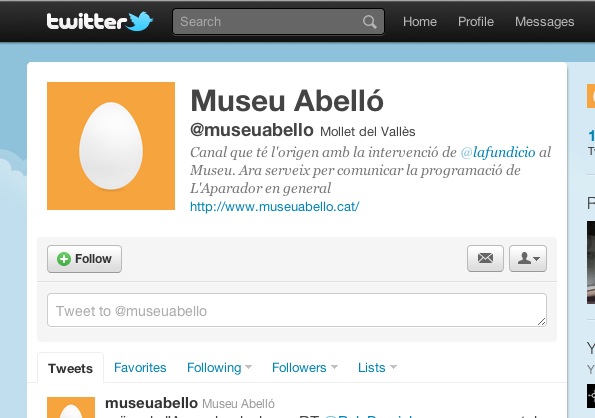

Twitter, the well-known social network and microblogging service that allows its users to send and read text entries with a maximum length of 140 characters called ‘tweets’, has been adopted by a large number of museum institutions as another channel of communication with their users (i.e. advertising). Instead of giving it such use, from LaFundició we propose to use this channel as a place for the production of discourse and public debate (an ‘arena’) during the time that the exhibition lasts. Specifically, we provide several secondary school students with a mobile device from which they can publish tweets on the Museu Abelló’s Twitter. The proposal launched to the students is to make, through this channel and in real time, a chronicle of their daily experience in their educational center. The open nature of the Twitter network allows this chronicle to be debated (also in real time) both by the LaFundició team and by any other Twitter user. The collaboration with the students will be established without the mediation of the educational center they attend.

LaFundició’s activity has focused on working with and in the educational sphere, and especially with and in the context of formal education. This is because we understand education and its institutions as essential elements in the construction and reproduction of cultural and social formations. Thus, we understand education as an eminently political sphere, a field in which the struggle is established to value and legitimize certain discourses and reference structures, while others are avoided and made invisible. The choice of which knowledge will form the consciences and habits of students is not innocent, and tends to reproduce the dominant power relations, while establishing itself as a mechanism of control over what can be said, done or thought.
This process of social reproduction is not carried out explicitly, but is articulated through the imposition of certain principles and values of classification and selection, rules of recognition and patterns of behavior. In order for students to assume and internalize this series of principles, values, rules and guidelines, subtle forms of coercion are used: schedules and routines, the division of groups by age, the distribution of spaces and the word, furniture, exams, reports and grades… What interests us is the chronicle that students can make of these small daily devices, barely perceptible, through the Museu Abelló channel on Twitter, and the debate that it may provoke. It is important for us that this work of the students is not included in the official curriculum of the institutes, and therefore that their chronicle is not supervised or evaluated by the teachers; for this reason, the students will be contacted directly, outside of school hours and spaces. We want to avoid that the students themselves self-censor and offer that chronicle that they understand, conforms to the valid discourse within the educational context and that they expect, is approved by their teachers (in that case we would find a perfect example of the usual functioning of a classroom).
This scenario highlights (metaphorically and literally) some of the tensions that the educational institution is experiencing today: firstly, its usual disagreement with Information and Communication Technologies (ICT) and especially with the social and cultural uses that young people make of them (the use of mobile phones is prohibited in most centers); and secondly, it points to the way in which the educational institution cuts off the flows of information and the transfer of knowledge between the inside and the outside –the institute is defined as a place governed by codes different from and isolated from those of its context and within which any public controversies about how learning should take place inside are deactivated-.
The Museu Abelló’s Showcase, although sui generis, is an exhibition space; the project aims to omit both the exhibition logic of the production and reception of the artistic object typical of the museum, and that of the reproduction of habits and discourses typical of the educational institution, and to affect to some degree and even temporarily, the structures and procedures that these institutions are responsible for perpetuating, with the hope of establishing other types of processes (communicative, of production and circulation of knowledge) more just. We think that the project responds to these intentions to some extent, generating and appropriating on the one hand, one of the possible communication channels of a museum, and on the other hand, connecting it with the knowledge and experience of a group of students; it seems to us that this device can enable an overflow of the limits imposed by the different institutions between their interior and their exterior, by allowing the knowledge and the voice of the students to circulate through channels that have not been designated to them in advance (neither by the museum nor by the school). What seems clear to us, in any case, is that the role of the students who collaborate in http://twitter.com/museuabello differs from that which they usually establish from the school with the museum, which relegates them to the function of mere depositories of the knowledge preserved by the museum itself.